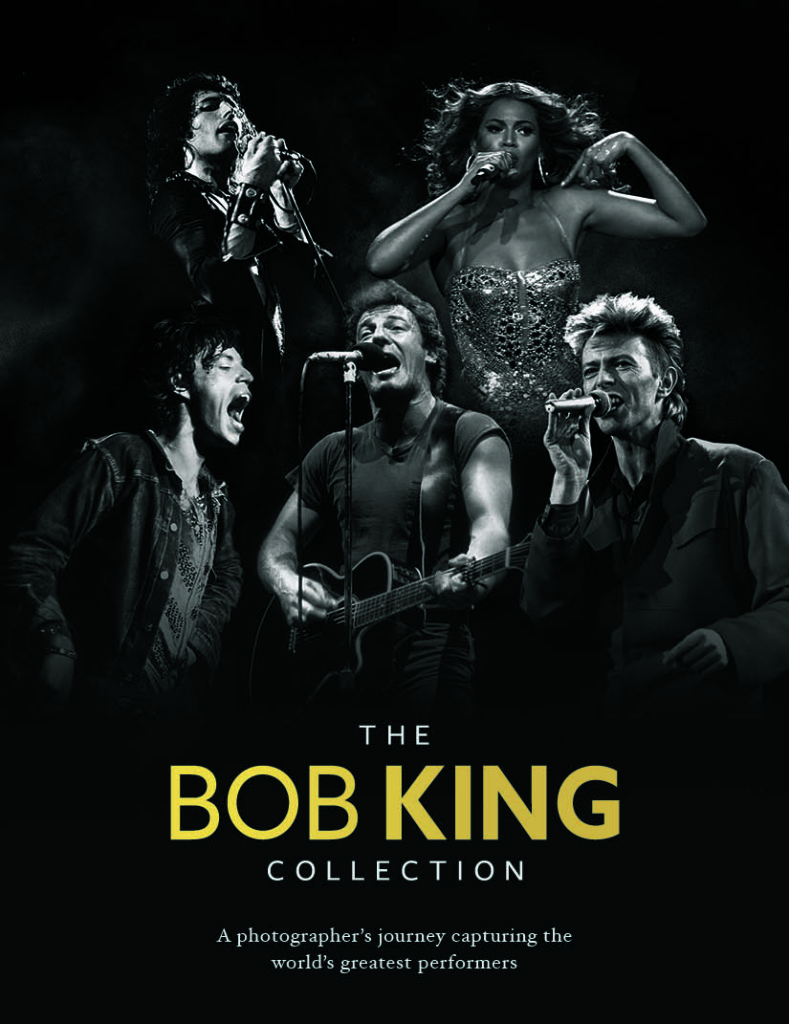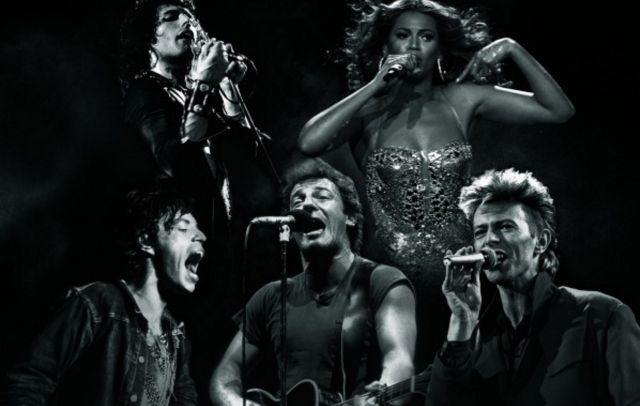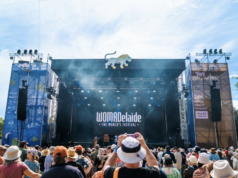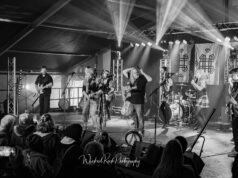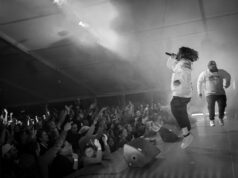Since the 1960s, legendary Aussie photographer Bob King has captured the heart and soul of music’s top icons through his masterful lens.The Bob King Collection, a showcase of his quintessential journey of popular music and musical performances over the last 50 years with never seen before images.
Mark Moray’s conversation with Bob King not only takes you through his early years as a photographer, but Bob also shares his views on the changing times from using film to digital cameras.
Mark Moray – In the 60s and 70s there would not have been too many photographers who were photographing gigs and concerts as a profession, so what made you decide that this was the path that you wanted to pursue?
Bob King – I was working at Kodak in the 60s and photographing rock ‘n’ roll was basically a hobby for me in the 60’s and probably until the mid to late 70’s when all the rock magazines started. I can remember going to see ‘The Rolling Stones’ out at the showground at Moore Park, and there were people in the audience asking why I was taking photos of the concert. There would be one guy who would come in from one of the daily newspapers with his big 4” x 5” camera. He would be a big old fellow in his late 20’s and I would be about 18 years old, and he would take two or three shots and run out of the place and that was basically it. I had two mates, one of them being Philip Morris, who is still around today shooting, and we would go to these concerts, and then in the mid to late 70’s the music magazines started to appear, RAM magazine, Juke Magazine, and until then, it was still a hobby. It wasn’t until probably the late 70’s when I started submitting photographs to overseas agencies to get my work published worldwide.
MM – You must have had a great love of music as well, wanting to shoot at concerts and gigs.
BK – Yeah, but I didn’t go to everything which was a disappointment because I missed out on certain acts. I would only go if I were really interested in the music. I would have to pay for the tickets in those days, and before computer tickets, the best place to get them was the box office, Hordern Pavilion at Moore Park. I would get down there at 4.00am in the morning and being the first half dozen people in the queue, that once the box office opened at 9.00am, we would end up getting Row A. This meant you would be in the front row so they couldn’t kick you out, but once computer tickets started, this system didn’t work.
MM – Being a hobbyist in the beginning, was there a Rock Photographer that might have influenced you in a way that made you feel that these are the reasons that you wanted to take photos at concerts?
BK – No I can’t say that there was anyone out there that influenced me. I just wanted to take photos. It was a hobby, and I was photographing other things as well. I was a member of a junior camera club at the YMCA, and concerts were just part of what I was shooting, and it was more interesting than anything else.
MM – Back then, all cameras were using film, and I imagine you would have been processing them yourself, so what excited you the most, taking the photos or processing the film?
BK – Well, it was taking them in the first place, because there were no barricades in those days, and lets say I would do a ‘Sherbet’ concert and would be amongst the hundreds of teenage girls who were there where security tried to hold them back which never seemed to work. Secondly, was the processing of the B&W shots and seeing the shots appearing out of the developing tray, and thirdly seeing the shots set up in print in the magazine.
MM – Did you do all your film processing at home?
BK – It was all done in the darkroom in the garage, but in the 60’s it was mainly colour film that was used, so I’d send the colour film off to the lab. In the 70’s I had my own darkroom.
MM – With little or no protection when up close to the stage, did you feel you were in danger when taking the photos, as you would have been knocked around?
BK – You had to be standing still while taking the shots, and at the same time you were being bustled by the audience, knocking you around, until the use of the pits came about, where you would share it with half a dozen other photographers, unlike today where there could be a dozen or more where it could get quite busy. In the early days where the film speed was so low, say we had 400 ISO film, you had to be on your toes to get a sharp shot and as the lighting wasn’t the best, it seemed like you had everything against you. It was quite difficult back then, where unlike today, for example, I did a gig last night and I was shooting on 6400 ISO for the band ‘Bullet For My Valentine’ as there was very little front or back lighting. Still you are really fighting to get a good image even at 6400 ISO.
MM – So digital cameras have now changed the way you approach in taking photos?
BK – Completely. During the film days you wouldn’t shoot much as you would know how much the film costs, but what you had in your advantage was that you were allowed to shoot the whole show, where as today with digital cameras, I would take over a 1000 images of the band like the gig I did last night, but you only have three songs to do it in. I am shooting with two cameras where I would have my finger on the motor drive and letting fly. Out of a sequence of 15-20 frames, I might just get one or two good ones, whereas trying to shoot that sequence one at a time with film you would never get that result.
MM – I guess with the digital camera of today you could take a sequence of shots, look at the photo and adjust the settings according to the lighting and the set up of the band, where as the days of using film you had to be more precise in hoping that you were getting it right.
BK – You had to nail it. Most times in those days you did, you weren’t hurrying, you didn’t have dozens of other photographers around you trying to get the same shot, and you learnt your craft, whereas unfortunately, and I don’t want to put a downer on it, but of todays shooters, many of them haven’t had any learning of photography. They have bought a digital camera, they turn up at a concert, and here I am a rock photographer.
MM – What camera gear are you using at the moment?
BK – I am using Nikon. I have been using Nikon since 1968 and I have a D750 and a D4, and lens wise, I use a 10.4mm Fisheye, a 24-70mm medium zoom and a 70-200mm longer zoom. All 2.8/f lenses, although these days you don’t really need to buy a 2.8/f lenses because you have the option of going higher of the ISO.
MM – Is there a favourite artist or band that you loved working with?
BK – Ah there are so many. I loved shooting (Cold) ‘Chisel’, ‘Midnight Oil’, ‘The Rolling Stones’; you just don’t get a bad shot with ‘The Rolling Stones’. I went on tour with Mick Jagger in 1988 as his photographer, and that was a thrill. I did the Brisbane and Sydney legs of that tour. That was when he had Joe Satriani as his lead guitar player, even before Joe Satriani was known. In the afternoons after the sound check you would hear this amazing guitar sound coming from the back of the stage and one afternoon I wandered round the back, and it was Joe Satriani scurrying through his chords.
MM – On the other hand, was there an artist or band that you felt really nervous photographing due to their reputation being either at the height of their career (‘The Rolling Stones’ or ‘U2’) or their treatment towards photographers (Liam Gallagher – ‘Oasis’)?
BK – Yeah they were quite heavy initially, and then I remember one tour where they said you could shoot with flash, so I let fly which you normally don’t do, they said you could use flash, so I did.
The only person I’d really been in awe of photographing was Frank Sinatra. I saw him up at Sanctuary Cove. He was one of the opening acts at Sanctuary Cove when it opened, and I was shaking and nervous in front of the stage because here is this icon that we have heard of, but basically he is the only one I could think of.
Probably in the early days you had a bit of nerves, but the more concerts you did the more you just overcame that. I can see who are the new photographers are in the pit these days as you look at them, and can see their hands are shaking, and also looking at the back of their camera after every shot.
MM – Is there an artist or band that you haven’t taken a photo of that you would have loved to?
BK – The two big misses were Led Zeppelin and Jimi Hendrix. I organised to go to London in 1971 hoping to shoot Hendrix as I planned the trip so far ahead, but he died nine months before I got there, and then while I was in London, Led Zeppelin were playing in Sydney. Of course there was Elvis, but he never travelled outside of America concert wise, and Janis Joplin would have been great to see.
MM – So are there any of the current artists that are still going around you haven’t photographed but would like to?
BK – I’ve shot most of them. There isn’t one act that’s on the bucket list at the moment that basically I haven’t already seen.
MM – You would have photographed bands or artists at the early stages of their career, have any of them became bigger than you thought they might have?
BK – Probably the B52’s and Devo’ they come to mind. INXS were amazing from day one; they just got better, better and better.
MM – Your new book “The Bob King Collection” was released this month, how is it going?
BK – I’m not sure at the moment. One of them (publisher) has just been to the Cologne book fair; I believe they have just sold it into Germany, which is good. The publisher ‘New Holland’ has offices in New York and London, so the books are going into both those areas as well as New Zealand. It is being shipped out this week I believe. It will be a couple of weeks before we know how it’s going. If the hits on the Facebook page I have are any indication, it will be flying out the door.
MM – How hard was it for you to choose photos from all the performances you have photographed over the last 50 years for your book?
BK – It was a difficult thing to do. I shot somewhere in the region of 6 million photos since the 60’s both B&W, colour and digital. That is over three and a half thousand concerts, events and red carpets. I did culls until I got down to 6000 photos and then the final 670 images that are in the book were culled out of that 6000, so it was a long involved process.
MM – How long did it take?
BK – I started scanning my colour photos since I got a scanner in the late 90’s and then over the last five years, I have been digitising all my B&W films, so to get it all done it has taken a long while, and the process for this book is probably four or five years in the making.
MM – The photo of the Bee Gees, which you took in 1965 standing on the lawn in Hyde park (which I love), could you please tell me how that photo came about?
BK – I have worked in the photographic industry, first for Kodak and then for professional dealers such as ‘Kayell Photographic’ and ‘L&P Photographic’ up until about 15 years ago. During my lunchtime, I would take my camera and walk around Hyde Park and basically photograph people, but one day while I was wandering around I thought to myself, there are the Bee Gees, so I just snapped the shot. This is one of the photos that I had forgotten about as it was lost amongst my B&W files until I started to scan my B&W images and all of a sudden it popped up there in full screen.
MM – What I love about this image is that the boys look so natural around their surroundings.
BK – I guess they had been doing some filming for some reason, probably for one of their songs and that is how it was.
MM – One of the hazards of being a Rock photographer, so close to the stage, would be the intense volume of the music. No doubt for different reasons, can you remember which concert was the loudest – ‘The Beatles’ or ‘The Who’?
BK – They were both loud in different ways, ‘The Beatles’, you couldn’t hear them basically as the audience were screaming. They could have just stood on stage and smiled, and the audience would still go bananas. ‘The Who’ that I saw in London were loud, but one of the loudest bands I ever photographed was Motörhead. I saw them firstly in a little club in Rydalemere – ‘The Family Inn’. The sound was just “humongous” and on top of that, I had been wearing earplugs to cut the noise down. Since the early 70’s I had started wearing earplugs. These days, you are in the pit for three songs, you have the earplugs on and you go away and you can still hear.
MM – Would you say it far more difficult today trying to make a living as a Rock Photographer, given that nearly everyone has a camera in his or her hand?
BK – Most definitely. From the 60’s until the late 90’s I was working days, nights, weekends and doing lots of music press, but now a days there is very little music press in this country, and so you do something like ‘Soundwave’ and the ‘Big Day Out’ music festivals and where there are the major acts playing, there can be up to 50 photographers in the pit. I only know about three of them and I have been doing this for forty odd years. They are working for blog sites and websites and I don’t think 80 percent of them are making any money at all. I sometimes wonder why some major overseas acts have photographers anyway as they would have had their photos taken over many years that could be used instead.
I will tell you a point in case; I was hired to photograph Barbara Streisand for four shows, two in Sydney and two in Melbourne. I was the only photographer in the country that photographed her. I was shooting from the sound desk using 600mm lenses and as soon as the film came out of my camera, it was taken out of my hand. Any of the photographs you would have seen in the press whilst she was here were all taken in Hawaii. They brought out a disk that had shots of her that were taken in Hawaii and used those. My shots they were happy with but they never got published in this country.
MM – Did you manage to get any of those photos back?
BK – No, I did ask the management if I could have a couple of photos for my portfolio, but I got a stern no!
MM – Do you keep in contact with any of the artists that you photographed?
BK – Basically when you see them you say hello at events like the ARIAS, (John) Farnham will always come up and say hello, who is a great guy to photograph. He will also mention me on stage. Jimmy (Barnes) recently did too at the Enmore Theatre gig he did a couple of weeks back.
MM – I guess the relationships built with the musicians for a photographer back in the 60’s, 70’s & 80’s are far different to how they are now?
BK – Yeah, back then you would get backstage. I have been backstage at INXS and U2, but these days you would rarely get backstage, you get your three songs or one song be it sometimes from the sound desk, you are marched in and you are marched out. Sometimes they don’t even let you stay to see the show, which is a pity.
MM – Finally Bob, if you could have an artist take your photo, who would it be?
BK – That’s a hard one. Mark Gable from the ‘Choirboys’ is into photography; I think he has taken my photo a couple of times. I think Daryl Braithwaite is into photography a little bit. I actually sold him a camera, and it was that which gave me access to the first ‘Sherbet’ concert I ever did in the 70’s. Philip Morris brought him into the shop where I was working and they were going to England on tour, and I sold him a camera Duty Free. Darryl gave me some tickets to see his show, and that was one of the things that pushed me on. I went to one ‘Sherbet’ show and then they did another show a couple of weeks later, and the next thing I am doing is showing the photos backstage to their management, and they would say that they wanted to buy them, and I thought I am making money out of something I love doing and that sort of spurred me on to do more, and here am today.
The Bob King Collection
by Bob King
NEW HOLLAND PUBLISHERS | OCTOBER 2016 | HARDBACK | RRP $99.99 |
